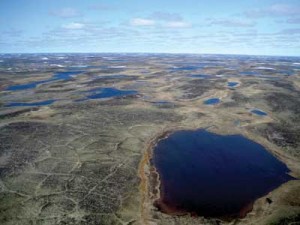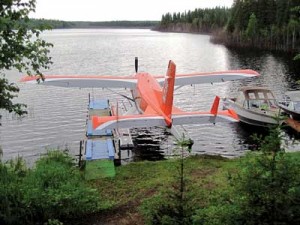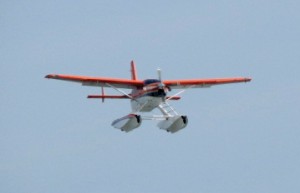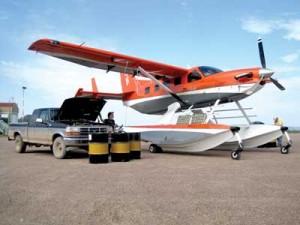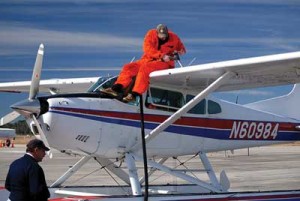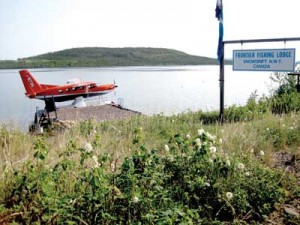by Rachel Obermoller
Aviation Representative – MnDOT Aeronautics
Photos by Walt Rhodes, USFWS
How many different jobs can you name for a seaplane pilot? Most pilots could probably call up a few things a working seaplane pilot might do: charter, scenic air tours, flight instruction, flying for a remote lodge, and maybe even working for an airline in an exotic island locale. What this list leaves off are the pilots who use their ratings to accomplish their jobs – being a pilot isn’t necessarily their job, but it helps them do the work they need to do.
At a former employer, I had the opportunity to work with pilots from around the globe as an instructor, ferry pilot, and maintenance test pilot. During my time there, I worked with several pilots from the U.S. Fish and Wildlife Service (USFWS). These pilot biologists use aviation as a means to accomplish the work they do, and are some of the most professional and safety conscious pilots I have had the privilege to fly with, and yet if you asked most of them what they do, you would hear them tell you about the conservation work they do, the species of bird they specialize in, or how they are biologists first and foremost.
These biologists are a lot of fun and are also excellent pilots, so I wanted to find out firsthand what their job requires, how they train for the flying they do, and what the average seaplane pilot can learn from them. I reached out to Walt Rhodes, one of pilots I did some flying and training with in the past, to find out a little more about flying for the USFWS and get some insight as the Midwest seaplane season gets started.
Walt’s background in conservation started long before he came to aviation. With a B.S. degree in Forestry and Wildlife and an M.S. degree in Wildlife Management from Virginia Tech, he worked as a wildlife biologist for the South Carolina Department of Natural Resources. Research during graduate school ultimately led him to become a pilot, but through a unique route. “I studied wintering habitat use of canvasbacks on Chesapeake Bay, partly which involved some aerial daytime surveys and weekly nighttime telemetry surveys,” he told me, “…and because of my aerial survey waterfowl experience for my graduate work, I began flying waterfowl surveys for the state as an observer. The pilot was a USFWS pilot-biologist who began recruiting me, thinking I might be good at the job and enjoy it.”
In 2004, three months of flight training led to a private pilot certificate in December, an instrument rating the following spring, time building, and a commercial license that summer. To build the 500 hours required to be hired as a pilot by the USFWS, Walt bought a 1963 Cessna 172. He was hired in February 2008 as a pilot biologist. Seaplanes are an important asset in the work the USFWS does “because ducks like water, [and] most of our operations, except for in the prairies, are conducted by seaplanes.” Many of the pilot biologists are seaplane pilots as a result, so Walt trained with Charlie Hammonds in Houma, Louisiana for his seaplane rating. “My first fun flying with seaplanes after passing my checkride was landing in narrow cypress canals in LA with Charlie…what a hoot!”
Since earning his seaplane rating, Walt has been assigned to a Cessna 206, Cessna 185, and now the Quest Kodiak, all on amphibious floats. These pilots train on a wide variety of topics, both to initially qualify to fly each make and model of aircraft, and also on a recurrent basis. “Flying seaplanes, water-ditching is required, with a two-year refresher,” said Walt. He continues “[It is] the best training anyone who flies floats could ever get.” In addition, USFWS pilots train on general topics like crew resource management (CRM), security, risk assessment, survival, first aid, CPR, and a bi-annual full week ground school and recurrent simulator and aircraft training in the Kodiak.
Much of the flying the USFWS does involves seaplanes. Floats provide options and allow them access to areas they could not reach with wheeled aircraft, in addition to improving safety during low-level flying over water. They also operate remote banding camps, and some locations are inaccessible by road or airport. Seaplanes allow them to set up camp, move in personnel, and resupply the camp while they operate in that location for up to a month.
When asked what he likes most about his job, he replies, “I’ve been fortunate to see nearly all of North America from the arctic to Mexico at 150 feet above the ground (and higher when ferrying). It is awesome to be able to see these landscapes and their wonders, including monitoring wildlife across the entire annual cycle. It is an awesome responsibility and privilege, and one that I don’t take for granted and would never abuse. There are very few people that do what I do and I appreciate that opportunity every day, as well as the burden on my family while I’m away during [wildlife] surveys. I couldn’t do it without their support. I also enjoy meeting all of the people that we do across the landscapes.”
I asked Walt to elaborate on some of the people he has met and stories of the flying he has done, and he told me how he first took for granted how much land there is to explore and how interesting each community is. As he has gotten to know the people in each place he has visited, he’s found interesting stories, a rich history, and innovative people.
He shared a story about a transient handyman who flies a 1948 Taylorcraft on floats out of Kasba Lake on the border between Nunavut and the Northwest Territories in Canada. He flies from lodge to lodge, and community to community, repairing things and working as he goes. He’s since seen this yellow Taylorcraft flying around throughout Canada, but he never would have learned the story about how this man uses his seaplane to make a living if he hadn’t been interested in the yellow seaplane they saw at the dock when they were flying surveys out of the area.
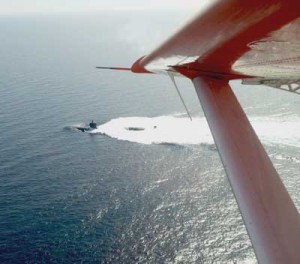
Sometimes you see interesting things when flying seaplanes offshore in the Atlantic Ocean. Photo Courtesy of Walt Rhodes, USFWS
There is a lot of work to be done during flying season, and the USFWS pilots stay busy and are gone from home for long stretches of time. “The big aerial push for me is from May to early June in northern Canada, and can extend for another period during the last two weeks of June into early July in the arctic. This is one of our core surveys monitoring breeding waterfowl populations,” Walt explains. They wait for the light to be ideal for the survey, minimizing shadows they might get on the water from the surrounding forests, and then they are airborne from about 0900 until 1600, with a short break for food and rest in the middle of the day. Before the flying even starts though, they are monitoring weather, making sure the aircraft is ready to go, and taking care of all of the other details which need to be resolved that day. After the flying ends, there is data to finish recording, weather to check for the next day, dinner to eat, and then it’s time to rest before the routine begins again the next day.
He tells me he has been fortunate to find Internet service in many of the locations he visits, meaning he has good access to weather information, the ability to communicate with family at home, as well as colleagues. The long stretch of surveys and then duck banding in August takes him away from home for weeks, but the surveys they conduct in fall and winter are typically shorter, lasting a few days.
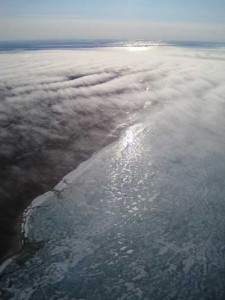
Sea fog rolling in off Queen Maud Gulf in the arctic is a constant consideration by pilots. Photo Courtesy of Walt Rhodes, USFWS
Flying can be challenging in the areas where these pilots operate. While the majority of flying is done VFR, they need to be prepared to shoot an instrument approach, especially if coastal fog rolls in. Filing IFR in VFR conditions when possible also offers opportunities to stay proficient on procedures and working with ATC. Sometimes, IFR isn’t an option though, as they are on floats and not equipped for icing conditions. The weather is one of the most challenging aspects of the job, he tells me, and “it can be frustrating, but when you realize you can’t change it…shouldn’t push it, it makes it challenging in a fun sort of way, and you don’t always have to go, which is the biggest part of the equation.” They’re often looking at weather for several days out; part science, part art, and part game of chance, but he enjoys reading the forecasts and model discussions and seeing how his analysis pans out.
Much of their work during surveys is flown at a low level, so they wear flight suits and helmets in this environment as safety precautions. Additionally, they carry necessary survival gear both on their life vests, and in the aircraft. “It depends on the operation,” he tells me, “but mostly a fully stocked inflatable PFD (personal flotation device). It includes the following items: water purification tablets, space blanket, HEEDs bottle (helicopter emergency egress device, a type of short duration underwater breathing system), multi-purpose tool, [signaling] laser, matches, seat belt cutter, portable satellite phone, and PLB (personal locator beacon). Onboard is also a full survival kit, including much of the same stuff, but also rope, a cooking stove, food, pots, a first aid kit, and sleeping bags. For extended overwater operations, a life raft is onboard. The plane also has an in-panel satellite phone.” These pilots go out with the gear they need to survive and be rescued in the event of an accident, incident, or mechanical failure, and they carry the necessary items on their body so it goes out the door with them – a good practice for all pilots, especially seaplane pilots.
Because they are flying with at least one other person when doing surveys, crew resource management is important. While the observer is often not a pilot, they are still a critical crewmember, as their presence allows the pilot to concentrate on flying and leave the bird watching to another set of eyes. This means a good briefing between those onboard is important, because as Walt explains, “Being in the low-level environment, it’s imperative that your crew member is intimately involved in the flight. You also have to respect their comfort level, too, and they have the right to cancel or abort a flight if they’re uncomfortable.”
Walt is quick to reiterate that he goes through seasons of intensive float flying and seasons where more time is spent in the office, on the ground, or operating from airport to airport with little opportunity to get on the water. Just like seaplane pilots who spend their winters locked in by ice, and other pilots who might not fly much over the winter, he spends time at the beginning of each season refreshing his seaplane flying. “I try to periodically hit the water throughout the year, and concentrate on some intensive water work prior to leaving for Canada in May,” he shares, and then goes on to describe one of the training activities he learned from an instructor. This instructor was a check pilot from the Office of Aircraft Safety who also trains with him periodically, and during that year’s brush up, he threw an inflated balloon out the window of the plane. He tells me it works well if the wind isn’t too strong, and in the middle of the water he had the opportunity to practice approaching the balloon, which was bobbing on the water, from various directions and using a variety of techniques.
Conversing with Walt, it becomes clear that these pilots work hard to maintain their professionalism, are always considering safety and thinking about how to best accomplish their tasks, but also enjoy the opportunities seaplanes afford them and have a lot of fun doing their jobs. This group of working pilots is just another example of one of the multitude of occupations available to a pilot, and Walt is a terrific example of a pilot who found a way to combine two interests into a career.
If you see an orange Kodiak out and about, chances are it is a USFWS pilot, and I suggest you introduce yourself and ask them to tell you a little bit about their work. You’ll be impressed at their aviation knowledge, as well as the work they do to protect the environment, which seaplane pilots enjoy so much.








